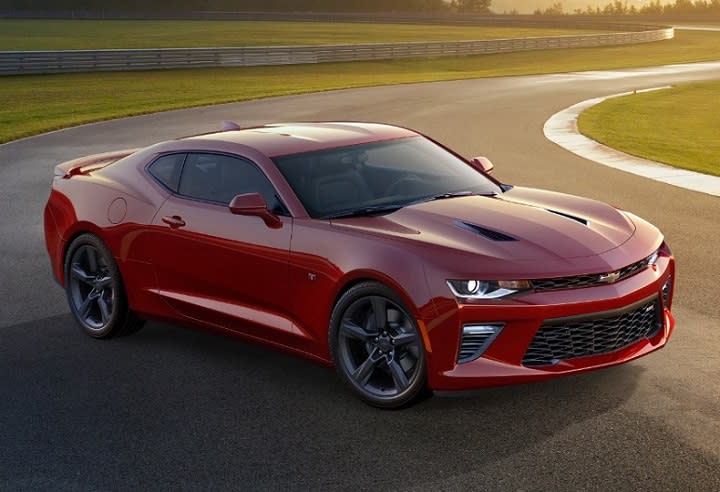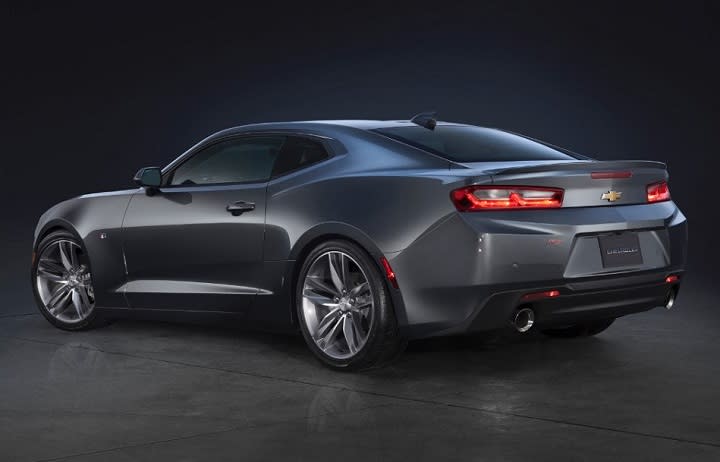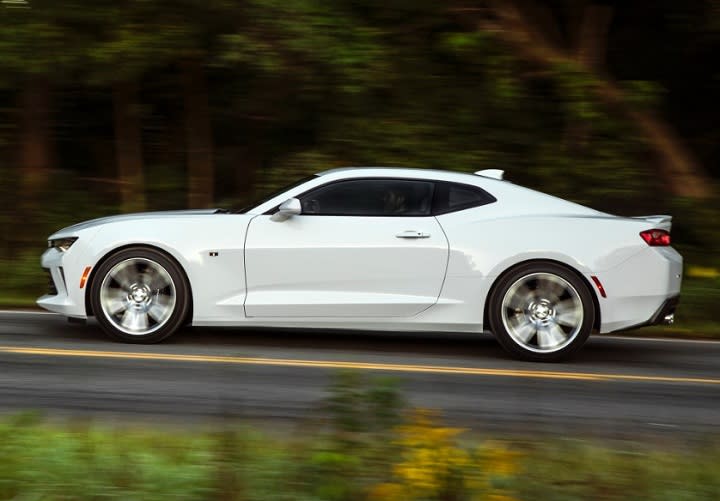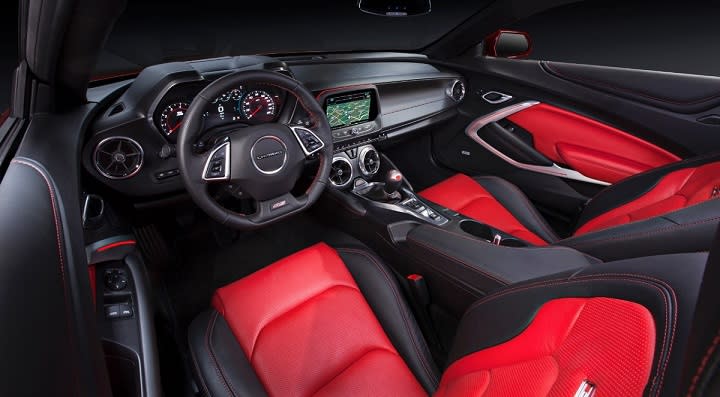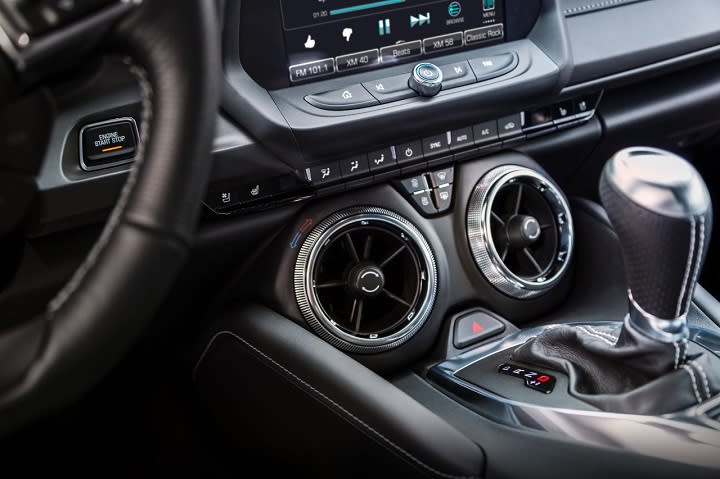PowerSteering: 2016 Chevrolet Camaro Review
Body Style:
Abstract:
Chevrolet has redesigned the iconic Camaro for 2016, though it might require more than a glance to tell the difference between the new version and the old version. Find out what our expert thinks of the 2016 Chevrolet Camaro in this exclusive review...
Year:
2 016
2016 Chevrolet Camaro SS front quarter photo Introduction
Chevrolet has redesigned the iconic Camaro for 2016, though it might require more than a glance to tell the difference between the new version and the old version. Drawing from the same design ethos used to relaunch the Camaro for the 2010 model year, the new 2016 Camaro remains inspired by the original late-1960s versions of the nameplate.
Under the bodywork, however, the new Camaro is thoroughly modern. It shares a platform with the Cadillac ATS, a luxury sport sedan that has drawn praise for its engaging driving dynamics. The 2016 Camaro comes in LT and SS trim levels, the former equipped with a turbocharged 4-cylinder or V-6 engine and the latter fitted with a powerful V-8.
For this review, our expert evaluated a 2016 Chevrolet Camaro 1LT with the RS package, Heavy-duty Cooling and Brake package, Technology package, black-painted wheels, Bright Yellow extra-cost paint, and premium floor mats. The price came to $30,575, including the $995 destination charge.2016 Chevrolet Camaro RS rear quarter photo What Owners Say
Before we discuss the results of our evaluation of the new 2016 Camaro, it is helpful to understand who bought the previous version of this sporty car and what they liked most and least about it.
The Midsize Sporty Car segment contains just four models. Naturally, then, Camaro buyer demographics closely align with those of the average buyer in the segment. Camaro buyers are slightly more likely to be men (82% compared with 81% segment average), a little bit younger (49 years vs. 51 years), and earn a slightly lower median annual household income ($102,679 vs. $106,338). The Camaro is also more popular with Gen X (born 1965-1976) and Gen Y (1977—1994) buyers (56% for both generations vs. 49% segment average).
Compared with the average Midsize Sporty Car buyer, Camaro owners identify themselves more often as practical buyers (24% vs. 30%) and less often as performance buyers (39% vs. 34%). They are also more likely to agree that they avoid vehicles they think will have high maintenance costs, compared with segment average (84% vs. 78%), and to agree that their first consideration in choosing a vehicle is miles per gallon (37% vs. 31%). In other respects, Camaro buyer psychographics are aligned with buyers of the Dodge Challenger, Ford Mustang, and Hyundai Genesis Coupe—the other members of the Midsize Sporty Car segment.
Buyers say that their favorite things about the Camaro are (in descending order) the engine/transmission, exterior styling, interior design, driving dynamics, and the climate control system. Buyers indicate that their least favorite things about the Camaro are (in descending order) interior storage and space, fuel economy, visibility and safety, seats, and the infotainment system.2016 Chevrolet Camaro side profile photo What Our Expert Says
In the sections that follow, our expert provides his own assessment of how the 2016 Camaro performs in each of the 10 categories that comprise the J.D. Power 2016 U.S. Automotive Performance, Execution and Layout (APEAL) Study.SM
Exterior
The new Camaro looks similar to the old Camaro, but the 2016 model is a smaller car. In every dimension, the new Camaro shrinks, and Chevrolet claims it loses 200 lbs. or more. The styling is familiar, but with more scallops and sharper creases the new design conveys greater definition and excitement.2016 Chevrolet Camaro interior photo Interior
Likewise, the new Camaro’s interior is modeled upon familiar themes. The dashboard is rather plain and simple, reflecting the car’s driver-focused mission and improved driving dynamics. Distraction is beautifully minimized, primary instruments and controls are easy to reference and use, and designers deftly integrate the climate system controls into the circular air vent trim rings to reduce clutter. Much of the Camaro’s interior, however, is covered in hard plastic.
2016 Chevrolet Camaro front seat photo Seats
Smaller inside, the Camaro no longer pretends that four people might actually sit inside of it at the same time. A rear seat exists, but even children complain about the lack of space.
Used for transporting a driver and a passenger, however, the Camaro is comfortable. The test car’s cloth-wrapped driver’s seat supplied robust bolstering, excellent thigh support, and plenty of leg space. Plus, when pitching the car into corners, the spots where the driver braces his or her legs are shaped to reduce discomfort. As an option, Camaro buyers can install soft padding in these locations.2016 Chevrolet Camaro infotainment and climate control system photo Climate Control System/Infotainment System
Climate Control System
If the Camaro’s interior looks plain, examine it further and you’ll spot genuine design brilliance. The automatic climate control system represents a good example of this.
A subtle row of climate buttons lines up horizontally across the middle of the dashboard, separating the MyLink infotainment system from the central air vents. Knurled metallic rings surround the air vents and twist to adjust temperature and fan speed.
The result is a clean, simple, functional design that surprises and delights the car’s owner.
Infotainment System
Chevrolet also effectively simplifies the Camaro’s MyLink infotainment system. Already refined to impressive standards, the MyLink display is large, colorful, and equipped with clean graphics and responsive virtual buttons.
At the bottom of the audio menu screen, radio station presets supply quick access to favorite sources of entertainment. Directly below the screen, Chevrolet includes a single power and volume knob flanked by buttons that make it easy to cycle up or down the spectrum to find the next set of stations. If you’d rather stream music, or connect via the USB cable to run Apple CarPlay or Android Auto, the Camaro’s MyLink technology supports that.
Furthermore, MyLink can be upgraded with navigation, and through a subscription to OnStar services Camaro owners can transform the car into a mobile 4G LTE Wi-Fi hotspot. The Camaro’s reversing camera—a requirement given poor rearward visibility—also uses the MyLink screen to display the view to the back of the car.2016 Chevrolet Camaro rear quarter left photo Storage and Space/Visibility and Safety
Storage and Space
More than anything, including fuel economy, owners of the previous-generation Camaro disliked the amount of interior storage and space. The 2016 redesign does not resolve this source of complaint.
There are few spots in which to stash things, unless you’re willing to use the cupholders for that purpose. The center console supplies nearly non-existent storage volume, and neither the glove box nor the small spaces integrated into the door panels are terribly accommodating.
The trunk is also smaller than it was before, shrinking to 9.1 cu. ft. On a positive note, the trunk’s square shape allows for maximum use of the space. It would be possible to carry two full-size suitcases, plus a few extra items.
Visibility and Safety
Despite the Camaro’s high beltline and small windows, outward visibility is better than expected.
Hood scallops provide a good view of the road ahead, large side mirrors help to eliminate blind spots, and a standard reversing camera supplies the necessary information to safely reverse the car. Options include rear park-assist sensors, a blind-spot warning system with rear cross-traffic alert, and a head-up display.
These driving aids help the Camaro’s driver to avoid an accident. Should one occur, the car earns top marks from the Insurance Institute for Highway Safety (IIHS) in every test parameter except roof-crush strength, for which the Camaro receives an “Acceptable” rather than a “Good” rating. This precludes the car from receiving a “Top Safety Pick” nomination.2016 Chevrolet Camaro manual shifter photo Engine/Transmission/Fuel Economy
Engine/Transmission
Three engine choices are offered for the 2016 Camaro.
The Camaro LT trims come with a standard turbocharged 4-cylinder engine generating 275 horsepower; a 335-horsepower, 3.6-liter V-6 engine is an option. An 8-speed automatic transmission is an option, replacing the standard 6-speed manual gearbox. With the automatic, the V-6 engine includes Active Fuel Management, a cylinder-deactivation system designed to improve fuel economy.
The Camaro SS is fitted with a 455-horsepower, 6.2-liter V-8 engine. It comes with a 6-speed manual or 8-speed automatic transmission, and with the automatic the V-8 employs Active Fuel Management technology.
The 1LT test car had the turbocharged 4-cylinder engine and the 6-speed manual transmission. Horsepower peaks at 5,600 rpm, while 90% or more of the 295 lb.-ft. of torque is available from 2,000 rpm to 4,500 rpm. The engine revs smoothly and sounds good doing so, supplying robust response. The manual gearbox provides short, precise throws, too, not at all like muscle cars of yore.
Occasionally, however, the engine displayed a steep drop in power during upshifts from first gear to second gear. The problem unexpectedly occurred just a couple of times, and when trying to match conditions the test driver could not duplicate the issue. It was not related to low-rpm shifts that would drop engine revs well below the threshold where torque makes its presence known in earnest.Fuel Economy
According to the EPA, the Camaro 1LT with the turbocharged 4-cylinder engine and 6-speed manual gearbox should return 24 mpg in combined driving. The test car got 21.9 mpg on the test loop.2016 Chevrolet Camaro front quarter left photo Driving Dynamics
When equipped with the larger 20-in. wheels included in the optional RS package, as well as the Heavy-Duty Cooling and Brake package, the Camaro 1LT provides tremendous bang for the buck.
Clearly, the platform it shares with the Cadillac ATS contributes to the Camaro’s penchant for opening clear lines of communication between the car, the driver, and the road. Unlike the previous Camaro, or the redesigned 2016 model’s primary competitors from Dodge and Ford, this new Camaro feels light, tidy, and athletic. Its talent extends beyond straight-line acceleration, transforming the Camaro into a sports coupe that performs beautifully on any type of road.
Thrilling engine response, a tight gearbox, stout braking components, expertly tuned electric steering, and a robust structure make driving a turbocharged Camaro a joy. The car doesn’t feel too big for twisting canyon roads, making it easier to carry speed through corners. And while visibility to the rear isn’t good, the scalloped hood provides the driver with clear lines of sight that, in turn, add confidence.
For daily driving, the ride quality is firm, but that’s to be expected. Road noise is excessive, and the more imperfect the pavement surface, the louder the cabin gets. More than anything, the annoying level of tire and suspension noise is what makes driving a Camaro tiresome during commutes.2016 Chevrolet Camaro rear photo Final Impressions
The redesigned 2016 Chevrolet Camaro might look like the previous version of the car, and it might resemble the comparatively rudimentary original cars of the late 1960s, but it drives more like a good German sports coupe than a sloppy American muscle car.
Shrink-wrapping the new Camaro around Cadillac ATS mechanicals hasn’t allowed Chevrolet to resolve key owner complaints. Interior space remains tight; there isn’t much storage space; and the trunk is smaller rather than larger. Fuel economy also falls short of expectations, and visibility remains a challenge, though new driver-assistance technologies do improve matters.
The good news is that Chevrolet has improved the Camaro in terms of powertrains and driving dynamics—key aspects that current owners claim are among their favorite things about the car. Styling and design are always personal preferences, but Chevy’s adherence to established themes is sure to please current Camaro owners.
From our reviewer’s perspective, the new Camaro represents an improvement over the previous car. Midsize sporty coupe buyers who need more interior room for people and things should consider the much roomier Dodge Challenger instead.
General Motors supplied the vehicle used for this 2016 Chevrolet Camaro review.
For more information about our test driver and our methodology, please see our reviewer profile.
Additional Research:
Check this if this is NOT an Articles Listing Page:
New or Used:
New
Display Article Date?:
Fuel:
Article Is Flipbook:
Yes

